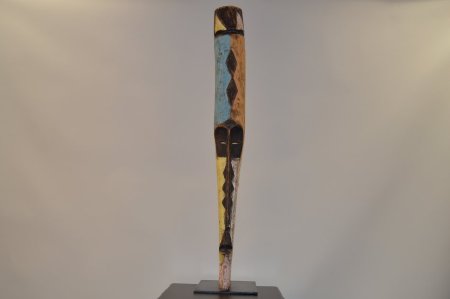Title:
Fang Style Ngil Mask
Object Name:
Mask, Fang, Ngil
Other Name:
Mask, Face, Fang
Place of Origin:
Fang, Gabon, Africa
Provenance:
Aboriginal Indigenous Art.
The Fang used masks in their secret societies. The ngil (gorilla) masks were worn by members of a male society of the same name during the initiation of new members and the persecution of wrong—doers. Masqueraders, clad in raffia costumes and attended by helpers, would materialize in the village after dark, illuminated by flickering torchlight. Fang masks, such as those worn by itinerant troubadours and for hunting and punishing sorcerers, are painted white with facial features outlined in black. Typical are large, elongated masks covered with kaolin and featuring a face that was usually heart—shaped with a long, fine nose. Apparently it has been linked with the dead and ancestors, since white is their color. The ngontang dance society also used white masks, sometimes in the form of a four—sided helmet—mask with bulging forehead and eyebrows in heart—shaped arcs. The ngontang mask symbolizes a ‘young white girl’. The so, or red antelope was connected with an initiation that lasted several months; these masks sport long horns.
The Fang used masks in their secret societies. The ngil (gorilla) masks were worn by members of a male society of the same name during the initiation of new members and the persecution of wrong—doers. Masqueraders, clad in raffia costumes and attended by helpers, would materialize in the village after dark, illuminated by flickering torchlight. Fang masks, such as those worn by itinerant troubadours and for hunting and punishing sorcerers, are painted white with facial features outlined in black. Typical are large, elongated masks covered with kaolin and featuring a face that was usually heart—shaped with a long, fine nose. Apparently it has been linked with the dead and ancestors, since white is their color. The ngontang dance society also used white masks, sometimes in the form of a four—sided helmet—mask with bulging forehead and eyebrows in heart—shaped arcs. The ngontang mask symbolizes a ‘young white girl’. The so, or red antelope was connected with an initiation that lasted several months; these masks sport long horns.
Description:
Wooden Fang Ngil mask. Elongated mask with heart—shaped face and long thin nose. Small almond—shaped pierced eyes and oval—shaped open mouth. Two diamond—shaped patterns in top front center area of mask. Multi—colored paint or patina covering entire surface area.
Collection:
Guy Mace Collection, (Turblex Company)
Material:
Wood W/Patina, Paint or Pigments
Used:
Ritually Used
Technique:
Carving / Painting
Owned:
Art Department, Missouri Southern State University
Accession#:
2015.2.77



